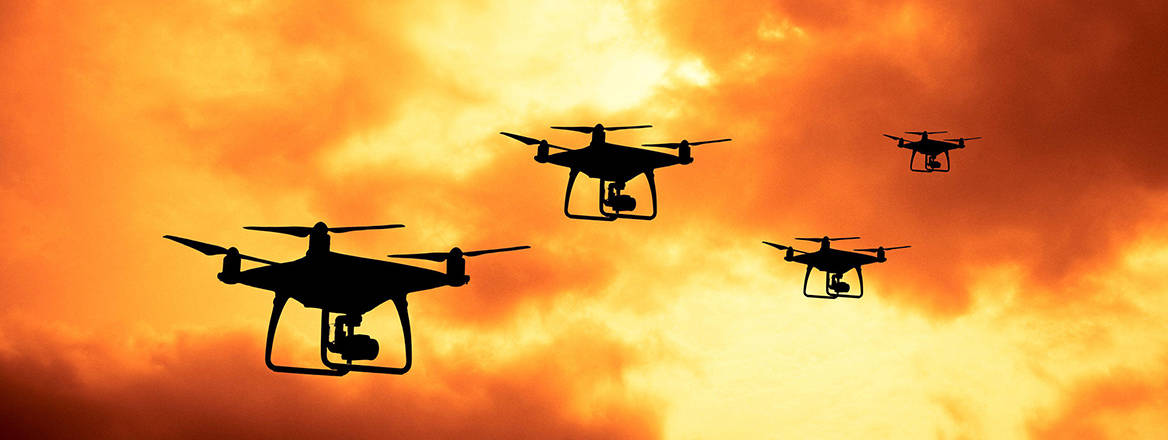Drone warfare has revolutionised the battlefield – it is urgent that regulatory barriers to training are modernised.
Uncrewed Aircraft Systems (UASs or drones) are now the principal weapons in the Ukraine War, accounting for an estimated 80% of all casualties there, (although it is widely believed that artillery would play a larger role on the Ukrainian side, if it were not for a shortage of suitable ammunition). This has already transformed the battlefield, and yet the capabilities of drones are developing at bewildering speed – with the recent remarkable attacks on the Russian strategic bomber fleet by what the Ukrainian SBU declared to be partially autonomous drones carried by civilian trucks.
The Trouble with Countermeasures
Countermeasures lag far behind. Jamming can be avoided by frequency hopping and is of course wholly ineffective against both fibre-optic ‘wire-guided’ and, in the near future, fully autonomous drones. Directed energy (DE) weapons are under development here as elsewhere and have some clear advantages but detecting and tracking UASs, particularly the wire-guided type, is difficult. They can fly low to the ground in the radar clutter and wait in cover, perhaps in long grass or behind windows, for vehicles to pass. And DE like kinetic responses, cannot be fired through another armoured vehicle or at a target approaching undetected from cover, making such vehicles extremely vulnerable where they are forced to bunch – for example in built up areas or at river crossings.
This has led to commentators like RUSI’s Jack Watling and Nick Reynolds to recommend ‘… counter-UAS capabilities are an all-arms requirement for survivability, and appropriate equipment and doctrine must be issued throughout NATO forces. The priority must be economical and sustainable engagements, with the reprogramming of Remote Weapon Stations (RWS) …. Without counter-UAS capabilities, NATO militaries risk seeing high quality troops and equipment rapidly suffering losses for want of protection... The scale of IFV and APC production is severely limited by an over-emphasis on quality over quantity.’
The need to protect armoured vehicles extends to supply vehicles, engineering plant, headquarters and every other aspect of combined arms operations; denied any one of these an army cannot operate. So, no army can be credible unless it is both equipped with UAVs, in a full range of roles including ISTAR, deep and local strike and rebroadcast roles – and, crucially – has the ability to counter them.
Training the Next Generation
The UK Army has made important, but uneven, progress on drone warfare. On the positive side, a ‘drone academy’ has been established, in partnership with jHUB, to provide distributed and scalable FPV foundation training and the Land Warfare Centre is training soldiers in the tactical employment of strike drones. Using drone racing and simulation. This should, in theory, spread the capability across multiple formations and units, while ensuring quality certification – a much better model, both for speed and for scalability than the centralised model operated by most of the arms schools for most equipments.
Entry to the courses is dependent on a test of basic drone skills not a preliminary course . . . the personal effort required of individuals outside supervised training self-selects soldiers with the commitment and enthusiasm to develop and maintain drone skills
Furthermore, entry to the courses is dependent on a test of basic drone skills not a preliminary course. This has two important benefits: first, it ensures that those who have acquired the skills through civilian drone racing and other activities do not waste time in covering old ground, as happens in many too Army courses (for example teaching the driving of land rovers from scratch to those who regularly use or even own one). Second, the personal effort required of individuals outside supervised training self-selects soldiers with the commitment and enthusiasm to develop and maintain drone skills. This is crucial as ‘skill fade’ with drones is extremely fast without regular practice. However, a reserve-friendly faster paced course is needed if the Army is to have a meaningful second echelon. The blossoming British Army Drone Sports Association offers a low cost, high value opportunity for people to develop and maintain basic skills.
Regulation Stifles Innovation
Unfortunately, all this progress is impeded by the regulatory structure for military drone operation. In an earlier article, last year this author set out how the UK’s bureaucratic approach to safety regulations is crippling the Army’s ability to train, and generating demoralising paperwork, no doubt contributing to the exodus of officers from the Army as well as lowering standards.
The organisation responsible for aviation matters is the Military Aviation Authority (MAA) and, far from recognising the need to show flexibility in a matter which is so central to the professionalism – indeed survivability – of UK Land Forces, it has chosen to limit most units’ ability to fly beyond visual line of sight (BVLOS) to 2km, a minimal range compared to distances seen on the battlefields of Ukraine. This is far more restrictive and less flexible than their civil counterparts, the Civil Aviation Authority (CAA), who have the Operating Safety Case model where operators can build a case to fly to any range as long as they prove the required level of safety.
Each regulator has a (different) multi-tiered classification system dependent on weight and operating distance, but the CAA allows for a clearer path to unlocking Beyond Visual Line Of Flight (BVLOS) flights. In contrast, the MAA allows only a very small number of units (mostly in the Royal Artillery) to ever operate at realistic ranges. Yet it is important that all parts of the Army learn the essentials of drone warfare, for the reasons already given.
This problem is compounded by arrangements for certifying drones carrying live weapons. It is of course right that regulators should be concerned about the safety of those using and responding to such weapons, but drones are being updated every few months, sometimes even in a matter of weeks so unless a really fast system of certification is introduced, the Army is likely to only be able to equip and live train with equipment long out of date. So far, the experience has been discouraging, with no small armed drones at all cleared for operation over land yet. (This is a problem mostly for the Army, as the other two services are focused on larger drones and/or operating over the sea).
Procurement and industrial policy will be important too. CGS’s imaginative approach of using SMEs and accelerators like jHub needs to be carried through in two ways. First, purchases for land warfare need to focus on civilian drone suppliers so that, as far as possible, all production lines are dual use – greatly reducing cost and building-in scalability in war. This means resisting lobbying from Defence major contractors to buy their expensive products, focussing on numbers, simplicity of operation and sustainability, as the Ukrainians are.
Second the country needs an industrial policy which ensures that components can all be sourced in the UK or close allies – removing the near total reliance on China for some categories.
Changes to the MAA are Pivotal
Whatever the priorities are eventually decided on in the Army’s equipment programme, future policy for the regulatory landscape for the MAA will be pivotal. The imaginative approach to introducing drones on the Army’s part outlined above is a model for the future of wider development and training. Yet it is now entirely vulnerable to structures and policies by the MAA designed for (small numbers of) aeroplanes, not for rapidly evolving, semi-disposable, ground hugging machines.
Two changes are needed. First, the classification system should move in the direction of the CAA, with a simple path to BVLOS operations. Second, a new clearance system tailor-made for assessing weaponised drones, in an orderly but much faster manner, needs to be introduced. Otherwise, instead of leading practise in modernisation, there is a serious risk that UK Land Forces will continue to be denied the essential means to train and deploy credible forces for a modern battlefield.
On the other hand, with the implementation of such reforms to regulation and industrial policy, a remarkable transformation in the UK’s Regular Army can take place, backed by a multiplier effect ensuring mass and sustainability, through the reserves and, in war, the wider civilian world. Civilian life is packed with drone talent and experience so the capability for a punchy second echelon can grow within reserve forces, while the distributed model of training is naturally adaptable to grow citizen forces from scratch for a third echelon.
© Julian Brazier, 2025, published by RUSI with permission of the author.
The views expressed in this Commentary are the author's, and do not represent those of RUSI or any other institution.
For terms of use, see Website Terms and Conditions of Use.
Have an idea for a Commentary you'd like to write for us? Send a short pitch to commentaries@rusi.org and we'll get back to you if it fits into our research interests. View full guidelines for contributors.
WRITTEN BY
Sir Julian Brazier
RUSI Distinguished Fellow, Military Sciences
- Jim McLeanMedia Relations Manager+44 (0)7917 373 069JimMc@rusi.org



